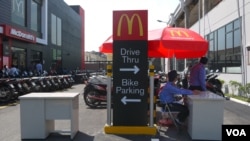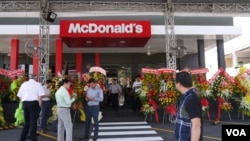McDonald’s marked its first birthday in Vietnam with a fourth restaurant earlier this month, reflecting a mixed year in Asia even as the company struggles to compete at home in the United States.
When the golden arches rose over Vietnam for the first time last year, there was international buzz for the new, long-awaited market, but the excitement was tempered by cultural and demographic challenges. Could consumers afford a value meal that costs as much as four bowls of pho? Would Vietnamese tastes give way to beef patties and fries?
Sean Ngo, CEO of VF Franchise Consulting, said companies focus on emerging countries like Vietnam as a strategy to “counter-balance” weak sales in industrialized countries.
“Many fast-food restaurant chains have been developing markets in Asia for the past two decades as a means of future growth for the brands in the U.S.,” said Ngo, who is based in Ho Chi Minh City and has offices in Thailand and Singapore.
Tainted meat scandal
Last summer the Big Mac maker suffered a tainted meat scandal that hit China and Japan, which plunged its Asia-Pacific, Middle East and Africa profits 55 percent. When asked if that affected consumers in Vietnam, marketing manager Thai Nguyen said, “A little bit.”
But Nguyen also said he was pleasantly surprised with the performance of the three restaurants in Ho Chi Minh City, which dished out more than one million burgers from February to December 2014.
“We did meet the target,” communications manager Tram Le said.
But one McDonald’s supplier said that, although the company believed in the future of McDonald’s, the first year did not go as expected. “I think they had hoped for something better,” the person said, asking not to be named. “We had volume projections that were not met this year.”
Observers say this may have something to do with local diets and incomes. McDonald’s is associated with beef because of its burgers, while Vietnamese traditionally eat more pork and chicken, which creates an opening for the likes of U.S.-based KFC and Japan’s Lotteria.
Reclining on his motorbike outside of the fourth McDonald’s on Thursday, Tran Quoc Dinh said he makes $5 to $10 a day from driving.
“Oh gosh, I drive a motorbike, where would I get money to eat McDonald’s? I need money to raise my kids,” Dinh said, digging into his Styrofoam box of fried tofu and rice.
But Dinh, 57, said many people have been walking by in recent days and asking him when the newest McDonald’s would open. He also pointed across the street to a KFC joint, saying his children went there on weekends and would try McDonald’s next.
Target market
In fact, family is a key demographic for the franchise, as 65 percent of Vietnam’s 90 million people are below 35. Nguyen said McDonald’s aims to create a “magical” experience and a weekend destination for Vietnamese families, which would jibe with corporate strategy elsewhere. In the United States, playgrounds and children’s meals hook customers early on and foster a nostalgia that carries into adulthood.
“We do it really well, kids love us,” Nguyen said.
The fourth McDonald’s is 30 minutes from downtown Ho Chi Minh City, where fast food rivals have flooded the market and real estate remains expensive. Incomes are lower on the city’s outskirts, but Nguyen said that away from the crowds there’s potential for growth. McDonald’s, after all, started off in U.S. suburbs.
“Really, our strategy is still the same, there’s huge opportunity to go to the outer areas,” he said.
Any chain will lose luster after the hubbub of a grand opening, as locals get familiar with a brand, but Ngo said that doesn’t mean the McDonald’s influence will decline. He said the company is playing the long game in Vietnam, planning to roll out 100 locations in a decade.
“While McDonald's revenues in Vietnam are expectedly down from initial sales when it first opened,” Ngo said, “they are still selling significantly more than competitors on a per unit basis and will continue to help shape the fast-food market in Vietnam.”
Decline in US
Growth in the Southeast Asian country is part of expansion plans across emerging markets. McDonald’s said in its 2013 annual report that it planned to open 800 restaurants in Asia, Africa, and the Middle East in 2014, compared with 300 in Europe and 250 in the United States.
Nguyen said that in young markets like Vietnam, his company has the chance to offer consumers something new, from motorbike drive-thrus to 24-hour service. But on its home turf, McDonald’s may be feeling the weight of an aging empire.
CEO Don Thompson resigned in January, after a year in which U.S. fast food workers went on strike and pricier rivals like Chipotle and Shake Shack nabbed market share. As the U.S. economy recovers, diners are more willing to shell out for higher-end burgers. That’s not the case in developing Asia, where people start to eat McDonald’s as their incomes grow.
“We should expect that rising consumerism of western — and specifically American — products in Asia will continue for decades to come,” Ngo said, “and will provide a counter-balance to likely declining sales in mature markets such as the U.S.”





